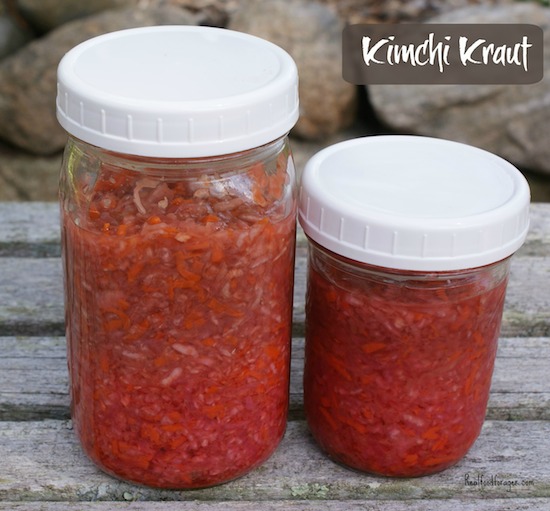I’ve been trying to incorporate more fermented foods into my daily diet because they are strong in probiotics. I eat plenty of garlic pickles and bread and butter pickles that I cultured over the summer from my very productive cucumber vines. However, it is my view that the more diverse cultured foods you eat, the better.
I’m in love with Daikon radish. I use it in salads, soups and now, I’ve used Daikon in my excellent Kimchi Kraut that is so easy to make at home. I make this without using cayenne pepper, (or other peppers) as we don’t tolerate nightshades, so it does not have the heat of traditional kimchi. I love it this way!
There are probably different strains of bacteria on the different vegetables (I would think) – as there are different strains of bacteria in different cultured dairy products, bread, meat and drinks.
Our Microbiota Work For Us
We can no longer separate our gut bacteria from who we are. Out of the emerging research on the microbiota and the microbiome, one thing is perfectly clear — the bacteria in our body outnumber the cells in our bodies and probably outperform us.
As noted in a previous post about beneficial bacteria, they perform many essential services:
- Microbial communities resist invasion by taking up space in the various niches and creating a space that is unwelcoming to foreign invaders. Balance is essential and research is showing that diversity is critical to good health.
- The microbiota manufacture neurotransmitters, enzymes, vitamins, amino acids and short chain fatty acids — all essential to good physical and mental health. An imbalance in these bacteria could trigger digestive and neurological problems as we see in autism, depression and Alzheimer’s — and of course digestive disorders.
- These bacteria produce signaling compounds that regulate appetite, satiety and digestion. Some are associated with obesity.
- The microbiota keep the immune system at an even keel — able to respond to invaders, and also to identify those others (resident bacteria) that are mutually beneficial to the host. A problem here could be at the core of autoimmunity.
Amplify Your Microbiome
We know how to extend our microbiome already — real food eaters have been saying this for years.
Of critical importance is the addition of fermented foods and beverages that add strains of bacteria and yeasts.
Start to introduce homemade yogurt, coconut milk yogurt, kefir, kombucha, beet kvass, sauerkraut, and pickles just to name a few. Incorporate these fermented foods into your diet in small portions at first as they pack a powerful amount of bacteria that can set off a Herxheimer reaction, or die-off, if introduced too quickly.
Those folks with a damaged microbiome may need more targeted treatments that restore the microbiome, such as Helminthic Therapy and Fecal Microbial Transplantation.
While it can take a little time to get used to eating and drinking all the different cultures, it is a good course of action to introduce new cultured products as you move along on your health journey.
When you change your microbiome, you can change your health.
Kimchi Kraut
Ingredients
- 1 small head of cabbage
- 1/2 small head of purple cabbage
- 1 medium Daikon radish
- 2 large carrots
- 4 – 5 cloves garlic minced
- 1 – 2 inches of fresh ginger minced
- 2 Tbsp sea salt (where to buy)
- 1/2 tsp starter mixed with 1/2 cup water (where to buy)
Equipment
- Food processor with grater attachment (where to buy a food processor)
- Bowl for mixing
- quart and pint ball jars with airlock lids or regular lids (where to buy)
- kraut pounder if you have one (optional) (where to buy)
- Glass weight (these really help keep the veges under the brine) (where to buy)
Instructions
- Grate all the vegetables and place in the bowl – leaving a few whole leaves aside
- Add the salt and starter
- Mix together and/or press for a few minutes with the kraut pounder or your fist – until the cabbage expresses some liquid
- Mix it all together well and press firmly into the ball jars
- Leave one inch at the top for expansion
- Cover the vegetables with the extra leaves and press under the brine – this helps keep it all under the brine
- Add extra filtered water if you need a little more liquid
- Place the weight on top if you are using one
- Cover and attach airlock if you are using one – or just use a regular lid
- Place on a plate and place on your fermentation shelf for one to two weeks (or longer – sometimes I leave it for 4 weeks) then refrigerate
- You can discard the cabbage leaves covering the kraut when you open the jar
- It keeps in the refrigerator for months
Tip: Save leaves of cabbage to cover and hold the vegetables under the brine
Prep Time: 15 minutes
Ferment time: 1 – 2 weeks
Yield: 1.5 quart













